SfDicer2 RNA Interference Inhibits Molting and Wing Expansion in Sogatella furcifera
Abstract
:Simple Summary
Abstract
1. Introduction
2. Materials and Methods
2.1. Laboratory Insects
2.2. Collection of Samples from Various Developmental Stages and Tissues
2.3. Total RNA Extraction and cDNA Synthesis
2.4. Sequencing Analysis, Design, and Synthesis of Specific Primers
2.5. Spatiotemporal Representation Analysis of SfDicer2
2.6. dsRNA Synthesis
2.7. SfDicer2 RNAi Analysis
2.8. Analysis of the Effects of the Silencing of SfDicer2 on Chitin and Wing Expansion-Related Genes
2.9. Statistical Analyses
3. Results
3.1. Sequence Characterization and Phylogenetic Analysis of SfDicer2
3.2. SfDicer2 Expression in Various Developmental Stages and Tissues
3.3. SfDicer2 RNAi Causes Wing Expansion Failure and Death in S. furcifera
3.4. Effects of SfDicer2 Silencing on the Gene Expression of Chitinase, Chitin deacetylase, Trehalase, and Chitin synthase in S. furcifera
3.5. Analysis of the Effects of Silencing SfDicer2 on Wing Expansion-Related Genes
4. Discussion
5. Conclusions
Supplementary Materials
Author Contributions
Funding
Institutional Review Board Statement
Informed Consent Statement
Data Availability Statement
Acknowledgments
Conflicts of Interest
References
- Wang, Y.; Zhang, H.; Li, H.; Miao, X. Second-generation sequencing supply an effective way to screen RNAi targets in large scale for potential application in pest insect control. PLoS ONE 2011, 6, e18644. [Google Scholar] [CrossRef] [Green Version]
- Chen, J.; Peng, Y.; Zhang, H.; Wang, K.; Zhao, C.; Zhu, G.; Reddy Palli, S.; Han, Z. Off-target effects of RNAi correlate with the mismatch rate between dsRNA and non-target mRNA. RNA Biol. 2021, 18, 1747–1759. [Google Scholar] [CrossRef]
- Xie, Z.; Johansen, L.K.; Gustafson, A.M.; Kasschau, K.D.; Lellis, A.D.; Zilberman, D.; Jacobsen, S.E.; Carrington, J.C. Genetic and functional diversification of small RNA pathways in plants. PLoS Biol. 2004, 2, E104. [Google Scholar] [CrossRef] [Green Version]
- Hatfield, S.D.; Shcherbata, H.R.; Fischer, K.A.; Nakahara, K.; Carthew, R.W.; Ruohola-Baker, H. Stem cell division is regulated by the microRNA pathway. Nature 2005, 435, 974–978. [Google Scholar] [CrossRef]
- Ghildiyal, M.; Zamore, P.D. Small silencing RNAs: An expanding universe. Nat. Rev. Genet. 2009, 10, 94–108. [Google Scholar] [CrossRef] [Green Version]
- Karlikow, M.; Goic, B.; Saleh, M.C. RNAi and antiviral defense in Drosophila: Setting up a systemic immune response. Dev. Comp. Immunol. 2014, 42, 85–92. [Google Scholar] [CrossRef] [Green Version]
- Tijsterman, M.; Plasterk, R.H. Dicers at RISC; the mechanism of RNAi. Cell 2004, 117, 1–3. [Google Scholar] [CrossRef] [Green Version]
- Carthew, R.W.; Sontheimer, E.J. Origins and mechanisms of miRNAs and siRNAs. Cell 2009, 136, 642–655. [Google Scholar] [CrossRef] [Green Version]
- Zhu, K.Y.; Palli, S.R. Mechanisms, applications, and challenges of insect RNA interference. Annu. Rev. Entomol. 2020, 65, 293–311. [Google Scholar] [CrossRef] [Green Version]
- Golden, D.E.; Gerbasi, V.R.; Sontheimer, E.J. An inside job for siRNAs. Mol. Cell 2008, 31, 309–312. [Google Scholar] [CrossRef]
- Kawamura, Y.; Saito, K.; Kin, T.; Ono, Y.; Asai, K.; Sunohara, T.; Okada, T.N.; Siomi, M.C.; Siomi, H. Drosophila endogenous small RNAs bind to Argonaute 2 in somatic cells. Nature 2008, 453, 793–797. [Google Scholar] [CrossRef]
- Liu, Q.; Rand, T.A.; Kalidas, S.; Du, F.; Kim, H.E.; Smith, D.P.; Wang, X. R2D2, a bridge betweenthe initiation and effector steps of the Drosophila RNAi pathway. Science 2003, 301, 1921–1925. [Google Scholar] [CrossRef]
- Kalidas, S.; Sanders, C.; Ye, X.; Strauss, T.; Kuhn, M.; Liu, Q.; Smith, D.P. Drosophila R2D2 mediates follicle formation in somatic tissues through interactions with Dicer-1. Mech. Dev. 2008, 125, 475–485. [Google Scholar] [CrossRef] [Green Version]
- Lee, Y.S.; Nakahara, K.; Pham, J.W.; Kim, K.; He, Z.; Sontheimer, E.J.; Carthew, R.W. Distinct roles for Drosophila Dicer-1 and Dicer-2 in the siRNA/miRNA silencing pathways. Cell 2004, 117, 69–81. [Google Scholar] [CrossRef] [Green Version]
- Lim, D.H.; Kim, J.; Kim, S.; Carthew, R.W.; Lee, Y.S. Functional analysis of dicer-2 missense mutations in the siRNA pathway of Drosophila. Biochem. Biophys. Res. Commun. 2008, 371, 525–530. [Google Scholar] [CrossRef] [Green Version]
- Lim, D.H.; Lee, L.; Oh, C.T.; Kim, N.H.; Hwang, S.; Han, S.J.; Lee, Y.S. Microarray analysis of Drosophila dicer-2mutants reveals potential regulation of mitochondrial metabolism by endogenous siRNAs. J. Cell. Biochem. 2013, 114, 418–427. [Google Scholar] [CrossRef]
- Zhang, X.Y.; Lu, K.; Zhou, J.L.; Zhou, Q. Molecular characterization and gene functional analysis of Dicer-2 gene from Nilaparvata lugens (Hemiptera: Geometroidea). Insect Sci. 2013, 20, 61–68. [Google Scholar] [CrossRef]
- Zhou, G.H.; Wen, J.J.; Cai, D.J.; Li, P.; Xu, D.; Zhang, S. Southern rice black-streaked dwarf virus: A new proposed Fijivirus species in the family Reoviridae. Chin. Sci. Bull. 2008, 53, 3677–3685. [Google Scholar] [CrossRef]
- Zhu, Z.R.; Cheng, J.A.; Liu, Y.G. A comparison of population biology of macropterous and brachypterous adults of Sogatella furcifera (Horvath). Chin. J. Rice Sci. 2001, 03, 70–73. (In Chinese) [Google Scholar]
- Zhou, C.; Yang, H.; Wang, Z.; Long, G.Y.; Jin, D.C. Comparative transcriptome analysis of Sogatella furcifera (Horváth) exposed to different insecticides. Sci. Rep. 2018, 8, 8773. [Google Scholar] [CrossRef]
- Wang, L.; Tang, N.; Gao, X.L.; Chang, Z.; Zhang, L.; Zhou, G.; Guo, D.; Zeng, Z.; Li, W.; Akinyemi, I.A.; et al. Genome sequence of a rice pest, the white-backed planthopper (Sogatella furcifera). GigaScience 2017, 6, giw004. [Google Scholar]
- Wang, Y.Y.; Yu, J.M.; Dai, L.L.; Cheng, H. Cloning and expression of two mevalonate pathway genes of Dendroctonus armandi. J. Northwest Univ. 2020, 35, 140–149. [Google Scholar]
- An, X.K.; Hou, M.L.; Liu, Y.D. Reference gene selection and evaluation for gene expression studies using qRT-PCR in the white-backed planthopper, Sogatella furcifera (Hemiptera: Delphacidae). J. Econ. Entomol. 2016, 109, 879–886. [Google Scholar] [CrossRef] [PubMed]
- Livak, K.J.; Schmittgen, T.D. Analysis of relative gene expression data using real-time quantitative PCR and the 2−ΔΔCT method. Methods 2001, 25, 402–408. [Google Scholar] [CrossRef]
- Lv, X.; Wang, W.; Han, Z.; Liu, S.; Yang, W.; Li, M.; Wang, L.; Song, L. The Dicer from oyster Crassostrea gigas functions as an intracellular recognition molecule and effector in anti-viral immunity. Fish Shellfish Immunol. 2019, 95, 584–594. [Google Scholar] [CrossRef]
- Ji, X.H. The mechanism of RNase III action: How dicer dices. Curr. Top. Microbiol. Immunol. 2008, 320, 99–116. [Google Scholar] [PubMed]
- Carmell, M.A.; Hannon, G.J. RNase III enzymes and the initiation of gene silencing. Nat. Struct. Mol. Biol. 2004, 11, 214–218. [Google Scholar] [CrossRef]
- Bronkhorst, A.W.; Leef, K.W.R.; Vodovar, N.; Ince, I.A.; Blanc, H.; Vlak, J.M.; Saleh, M.C.; van Rij, R.P. The DNA virus Invertebrate iridescent virus 6 is a target of the Drosophila RNAi machinery. Proc. Natl. Acad. Sci. USA 2012, 109, E3604–E3613. [Google Scholar] [CrossRef] [PubMed] [Green Version]
- Yamada, S. Dual wing-form determination mechanism in the brown planthopper, Nilaparvata lugens STL(Homoptera:Delphacidae). Appl. Entomol. Zool. 1991, 26, 590–592. [Google Scholar] [CrossRef]
- Jiang, Y.Q. Sensitive Period of Wing-Morph Determination in the Brown Planthopper. Master’s Thesis, Zhejiang University, Hangzhou, China, August 2016. (In Chinese). [Google Scholar]
- Arrese, E.L.; Soulages, J.L. Insect fat body: Energy, metabolism, and regulation. Annu. Rev. Entomol. 2010, 55, 207–225. [Google Scholar] [CrossRef] [Green Version]
- Kandasamy, S.K.; Zhu, L.; Fukunaga, R. The C-terminal dsRNA-binding domain of Drosophila Dicer-2 is crucial for efficient and high-fidelity production of siRNA and loading of siRNA to Argonaute2. RNA 2017, 23, 1139–1153. [Google Scholar] [CrossRef] [Green Version]
- Cagliari, D.; Dias, N.P.; Dos Santos, E.Á.; Rickes, L.N.; Kremer, F.S.; Farias, J.R.; Lenz, G.; Galdeano, D.M.; Garcia, F.R.M.; Smagghe, G.; et al. First transcriptome of the Neotropical pest Euschistus heros (Hemiptera: Pentatomidae) with dissection of its siRNA machinery. Sci. Rep. 2020, 10, 4856. [Google Scholar] [CrossRef]
- Gao, L.; Wang, Y.; Abbas, M.; Zhang, T.; Ma, E.; Xing, S.; Zhu, K.Y.; Zhang, J. Molecular characterizations and functional analyses of LmR2D2 in the Locusta migratoria siRNA pathway. Insects 2021, 12, 812. [Google Scholar] [CrossRef] [PubMed]
- Cai, Y.L.; Zheng, X.L. Cloning of AGO2 and Dcr-2 gene fragments and analysis of their transcription level in different developmental stages of Aedes albopictus. Chin. J. Parasitol. Parasit. Dis. 2012, 30, 214–217. (In Chinese) [Google Scholar]
- Garbutt, J.S.; Reynolds, S.E. Induction of RNA interference genes by double-stranded RNA; implications for susceptibility to RNA interference. Insect Biochem. Mol. Biol. 2012, 42, 621–628. [Google Scholar] [CrossRef] [PubMed]
- Lozano, J.; Gomez-Orte, E.; Lee, H.J.; Belles, X. Super-induction of Dicer-2 expression by alien double-stranded RNAs: An evolutionary ancient response to viral infection? Dev. Genes Evol. 2012, 222, 229–235. [Google Scholar] [CrossRef] [PubMed]
- Ye, C.; An, X.; Jiang, Y.D.; Ding, B.Y.; Shang, F.; Christiaens, O.; Taning, C.N.T.; Smagghe, G.; Niu, J.; Wang, J.J. Induction of RNAi core machinery’s gene expression by exogenous dsRNA and the effects of pre-exposure to dsRNA on the gene silencing efficiency in the pea aphid (Acyrthosiphon pisum). Front. Physiol. 2019, 10, 1–10. [Google Scholar] [CrossRef] [Green Version]
- Shen, X.J. Genome-Wide Characterization and Expression Profiling of the RNAi Pathway Genes in Plutella xylostella (L.) and Functional Analysis of PxDcr-2; Fujian Agriculture and Forestry University: Fuzhou, China, 2016. (In Chinese) [Google Scholar]
- Davis-Vogel, C.; Ortiz, A.; Procyk, L.; Robeson, J.; Kassa, A.; Wang, Y.; Huang, E.; Walker, C.; Sethi, A.; Nelson, M.E.; et al. Knockdown of RNA interference pathway genes impacts the fitness of western corn rootworm. Sci. Rep. 2018, 8, 7858. [Google Scholar] [CrossRef] [PubMed]
- Davis-Vogel, C.; Van Allen, B.; Van Hemert, J.L.; Sethi, A.; Nelson, M.E.; Sashital, D.G. Identification and comparison of key RNA interference machinery from western corn rootworm, fall armyworm, and southern green stink bug. PLoS ONE 2018, 13, e0203160. [Google Scholar] [CrossRef] [Green Version]
- Zhang, H.; Li, H.C.; Miao, X.X. Feasibility, limitation and possible solutions of RNAi-based technology for insect pest control. Insect Sci. 2013, 20, 15–30. [Google Scholar] [CrossRef]
- Zhang, J.; Liu, X.; Zhang, J.; Li, D.; Sun, Y.; Guo, Y.; Ma, E.; Zhu, K.Y. Silencing of two alternative splicing-derived mRNA variants of chitin synthase 1 gene by RNAi is lethal to the oriental migratory locust, Locusta migratoria manilensis (Meyen). Insect Biochem. Mol. Biol. 2010, 40, 824–833. [Google Scholar] [CrossRef] [PubMed]
- Tang, B.; Wei, P.; Zhao, L.; Shi, Z.; Shen, Q.; Yang, M.; Xie, G.; Wang, S. Knockdown of five trehalase genes using RNA interference regulates the gene expression of the chitin biosynthesis pathway in Tribolium castaneum. BMC Biotechnol. 2016, 16, 67. [Google Scholar] [CrossRef] [PubMed] [Green Version]
- Shao, Z.M.; Ding, J.H.; Jiang, D.L.; Liu, Z.X.; Li, Y.J.; Wang, J.; Wang, J.; Sheng, S.; Wu, F.A. Characterization and Functional Analysis of trehalase Related to Chitin Metabolism in Glyphodes pyloalis Walker (Lepidoptera: Pyralidae). Insects 2021, 12, 370. [Google Scholar] [CrossRef]
- Zhao, L.; Yang, M.; Shen, Q.; Liu, X.; Shi, Z.; Wang, S.; Tang, B. Functional characterization of three trehalase genes regulating the chitin metabolism pathway in rice brown planthopper using RNA interference. Sci. Rep. 2016, 6, 27841. [Google Scholar] [CrossRef] [PubMed] [Green Version]
- Quan, G.; Ladd, T.; Duan, J.; Wen, F.; Doucet, D.; Cusson, M.; Krell, P.J. Characterization of a spruce budworm chitin deacetylase gene: Stage- and tissue-specific expression, and inhibition using RNA interference. Insect Biochem. Mol. Biol. 2013, 43, 683–691. [Google Scholar] [CrossRef] [PubMed]
- Yang, X.B.; Zhou, C.; Gong, M.F.; Yang, H.; Long, G.Y.; Jin, D.C. Identification and RNAi-based functional analysis of four chitin deacetylase genes in Sogatella furcifera (Hemiptera: Delphacidae). J. Insect Sci. 2021, 21, 9. [Google Scholar] [CrossRef]
- Yang, X.B.; Zhou, C.; Long, G.Y.; Yang, H.; Chen, C.; Jin, D. Characterization and functional analysis of chitinase family genes involved in nymph-adult transition of Sogatella furcifera. Insect Sci. 2021, 28, 901–916. [Google Scholar] [CrossRef]
- Strigini, M.; Cohen, S.M. Formation of morphogen gradients in the Drosophila wing. Semin. Cell Dev. Biol. 1999, 10, 335–344. [Google Scholar] [CrossRef] [PubMed]
- Erickson, J.L. Formation and maintenance of morphogen gradients: An essential role for the endomembrane system in Drosophila melanogaster wing expanse. Fly 2011, 5, 266–271. [Google Scholar] [CrossRef]
- Morgan, T.H. The theory of the gene. Am. Nat. 1917, 51, 513–544. [Google Scholar] [CrossRef]
- Xu, Z.L.; Zhang, F.B.; Wu, Z.C.; Zhang, J.; Zhang, J.Z.; Zhao, X.M. Function analysis of LmNotch in the wing development of Locusta migratoria. Chin. J. Biol. Control. 2021, 18, 1–12. (In Chinese) [Google Scholar]
- Dircksen, H.; Tesfai, L.K.; Albus, C.; Nässel, D.R. Ion transport peptide splice forms in central and peripheral neurons throughout postembryogenesis of Drosophila melanogaster. J. Comp. Neurol. 2008, 509, 23–41. [Google Scholar] [CrossRef]
- Charron, Y.; Madani, R.; Combepine, C.; Gajdosik, V.; Hwu, Y.; Margaritondo, G.; Vassalli, J.D. The serpin Spn5 is essential for wing expansion in Drosophila melanogaster. Int. J. Dev. Biol. 2008, 52, 933–942. [Google Scholar] [CrossRef]
- Yu, B.; Li, D.T.; Wang, S.L.; Xu, H.J.; Bao, Y.Y.; Zhang, C.X. Ion transport peptide (ITP) regulates wing expansion and cuticle melanism in the brown planthopper, Nilaparvata lugens. Insect Mol. Biol. 2016, 25, 778–787. [Google Scholar] [CrossRef] [PubMed]
- Li, X.; Liu, F.; Wu, C.; Zhao, J.; Cai, W.; Hua, H. Decapentaplegic function in wing vein development and wing morph transformation in brown planthopper, Nilaparvata lugens. Dev. Biol. 2019, 449, 143–150. [Google Scholar] [CrossRef] [PubMed]
- Long, G.Y.; Yang, J.P.; Jin, D.C.; Yang, H.; Zhou, C.; Wang, Z.; Yang, X.B. Silencing of decapentaplegic (Dpp) gene inhibited the wing expansion in the white-backed planthopper, Sogatella furcifera (Horváth) (Hemiptera: Delphacidae). Arch. Insect Biochem. Physiol. 2022, 110, E21879. [Google Scholar] [CrossRef]
- Yu, J.L.; An, Z.F.; Liu, X.D. Wingless gene cloning and its role in manipulating the wing dimorphism in the white-backed planthopper, Sogatella furcifera. BMC Mol. Biol. 2014, 15, 20. [Google Scholar] [CrossRef] [Green Version]
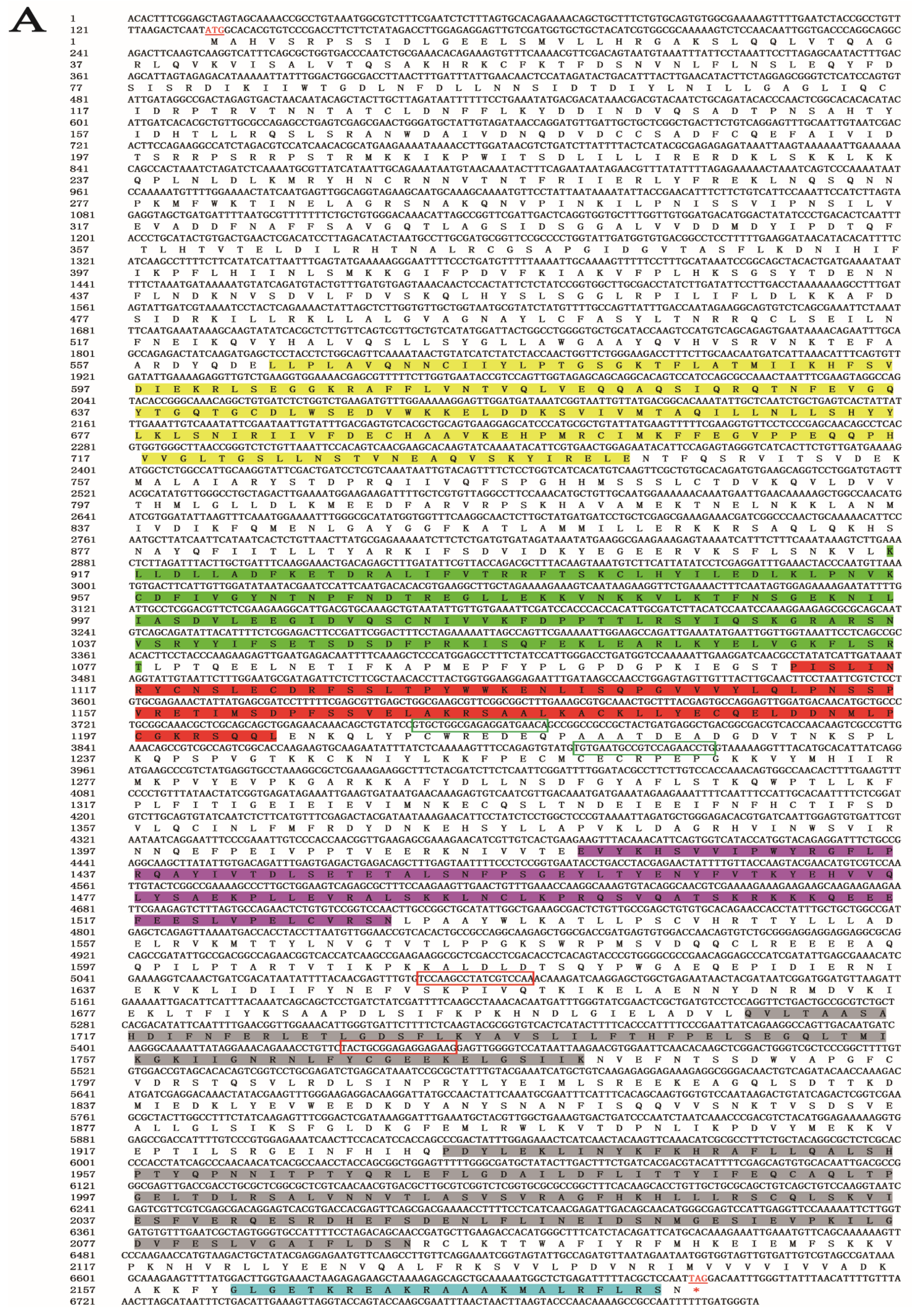

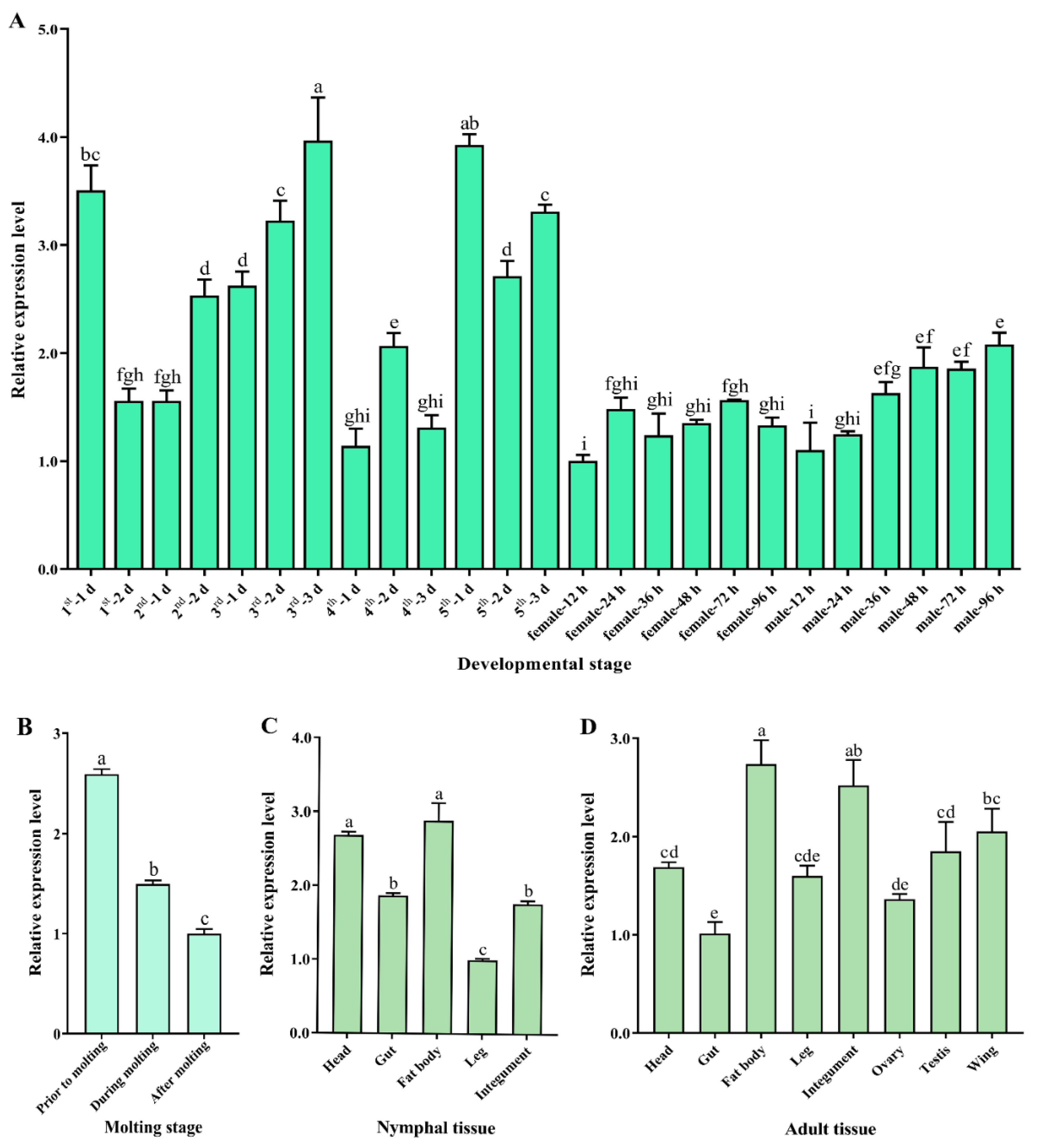
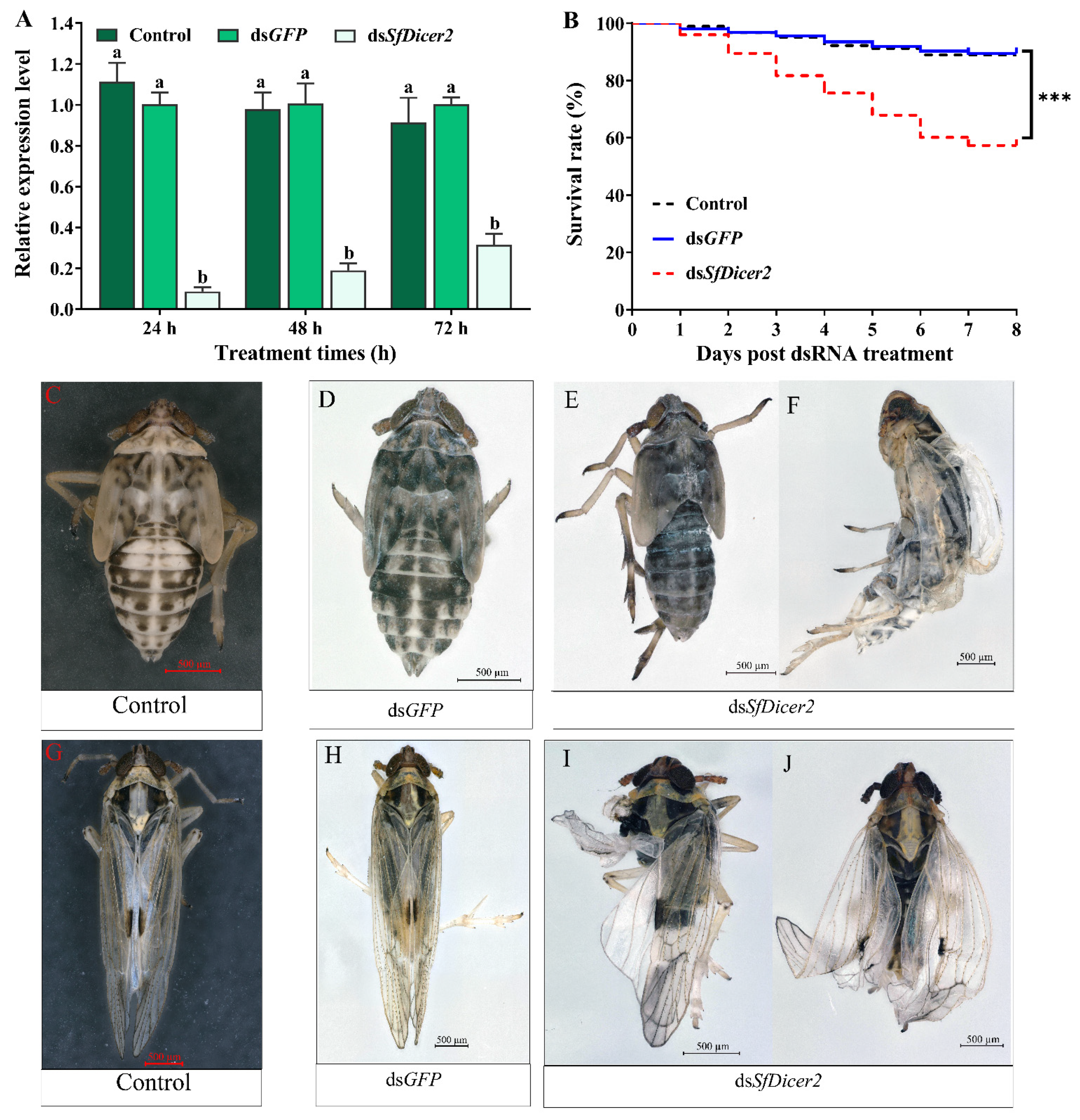
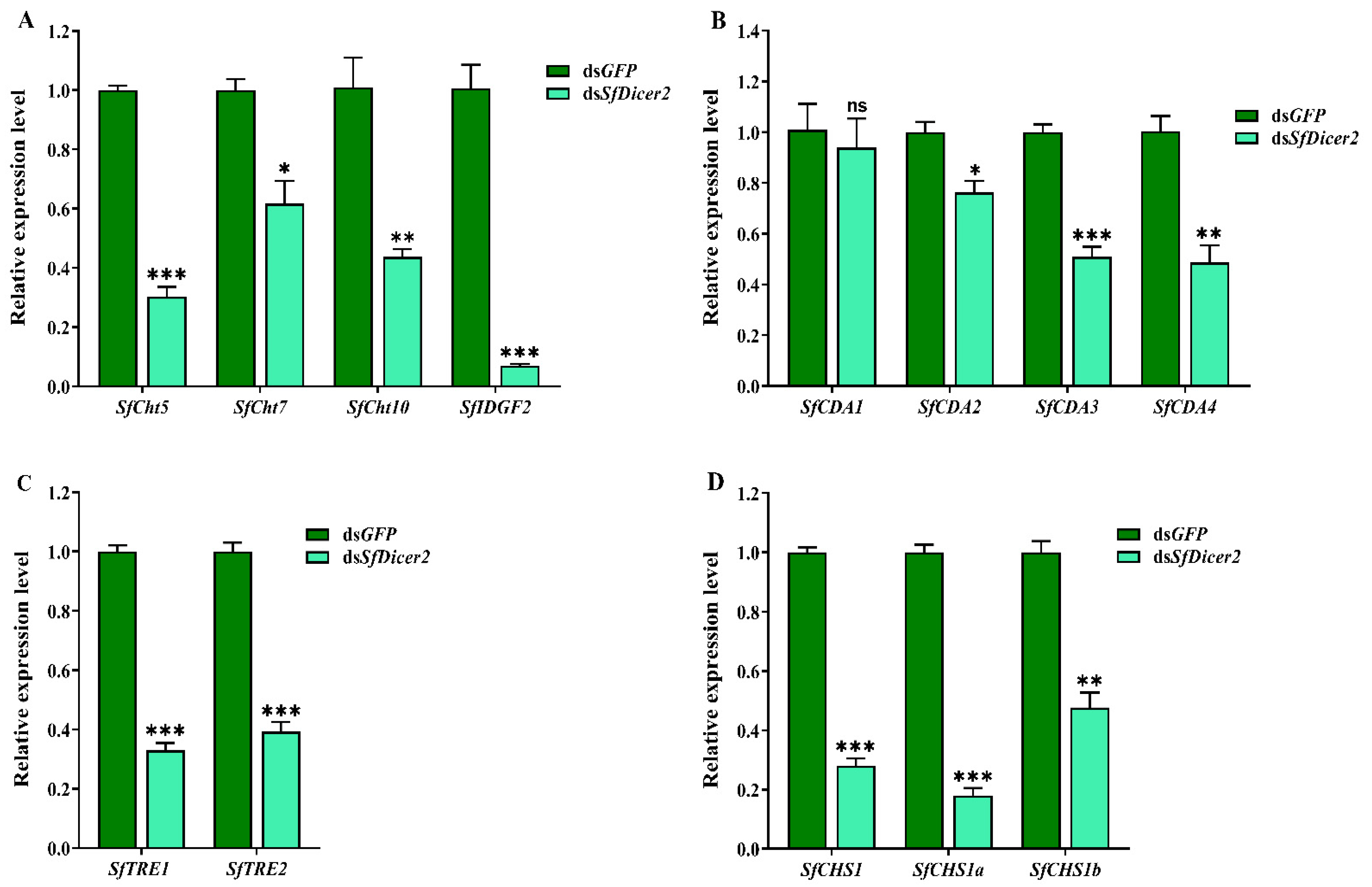
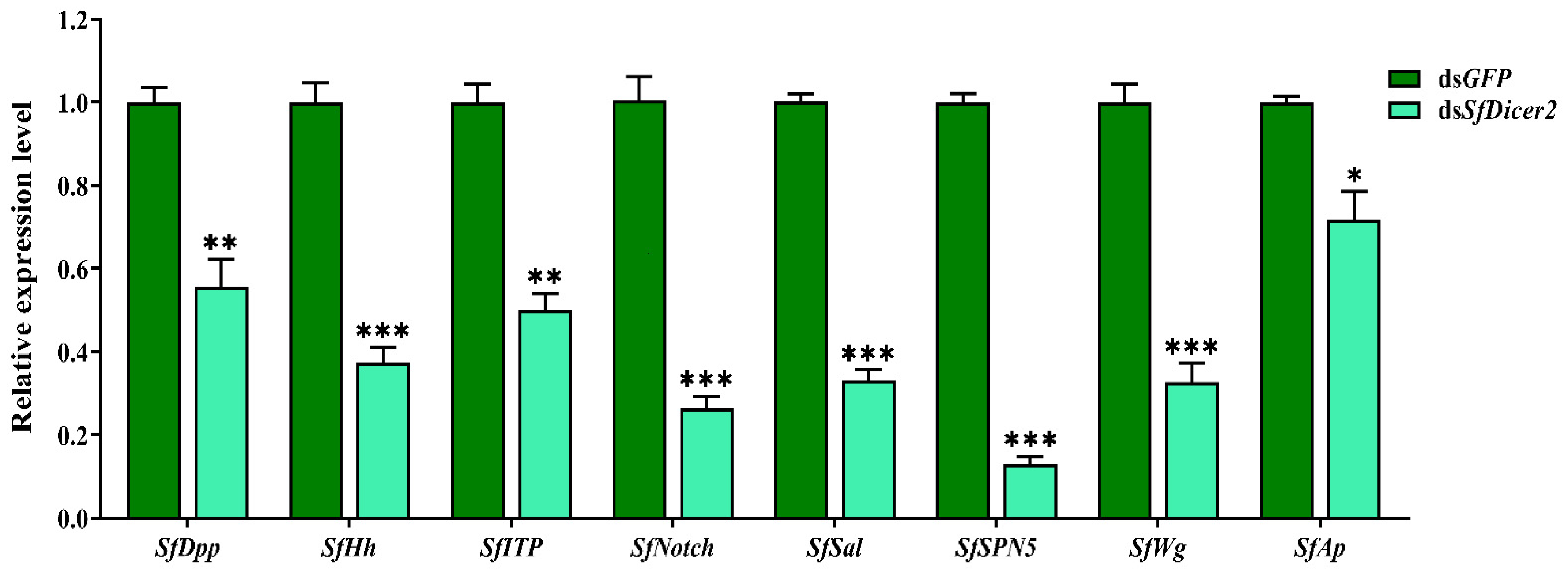
| Purpose | Primer Name | Primer Sequence (5′–3′) |
|---|---|---|
| RT-qPCR analysis | SfDicer2-F | GTGCTGGCGAGAGGATGAACA |
| SfDicer2-R | CAGGTTCTGGACGGCATTCACA | |
| SfCht5-F | GAACTACGCACAGCCTTCCTCAA | |
| SfCht5-R | CCAGTTGCCTCTCAAGTCATACGA | |
| SfCht7-F | CGGAATGCCAACTTACGGACGC | |
| SfCht7-R | CGCAGCATCTCGCACACCTCATAG | |
| SfCht10-F | GCCGAATACCTGGACTGGATCTCT | |
| SfCht10-R | TCAAGCCGTGCTGCTCCTTCT | |
| SfIDGF2-F SfIDGF2-R | TGTCAACCGACGCACCTTCCT CGAGACCCTGATACGCTGAGAGT | |
| SfCDA1-F | TCACATTCAACGGTGCCATCAAC | |
| SfCDA1-F | GCCATCTCAGCCAACCAATCATC | |
| SfCDA2-F | TCCATCACGCACAATGACGAAGAA | |
| SfCDA2-R | GAACTGGTTGTTGCCTCCGACTC | |
| SfCDA3-F | ACACAGCCGCATGTCAACTACC | |
| SfCDA3-R | ATCTCGCAGCCATTCGGATTACG | |
| SfCDA4-F | TCCGATTGCCGCCACCTTCTAT | |
| SfCDA4-R | CTCAAGACGCACTCCACCATAAGC | |
| SfTRE1-F | GACTTCTGCTATGTGATATGC | |
| SfTRE1-R | GCTGTCCACCATCTGAATA | |
| SfTRE2-F | GTGGTTGGATGCTGTTACTA | |
| SfTRE2-R | GAGATGTTTGTCGGGTAGAA | |
| SfCHS1-F | GATTGGTCATTGGCTTCAGA | |
| SfCHS1-R | GTAATGTCTTGCTTCGTCAG | |
| SfCHS1a-F | CTTCGGTGTTTGGTTTCTT | |
| SfCHS1a-R | TGGGTAACATCATCATAGGA | |
| SfCHS1b-F | GAGAAGGCGAGAATAGCA | |
| SfCHS1b-R | GCAGCAAGAACACGATTA | |
| SfDpp-F | CGCAGTCGTGTCGTTGTTCCT | |
| SfDpp-R | TCTGGTCGATGTCGCTCTCCTTAT | |
| SfHh-F | GCGACAGCCAGGTGACAACAT | |
| SfHh-R | CGTAGAAGGAGATGCGAGGGTGT | |
| SfITP-F | TTCAGTGCAAGGGTGTCTACG | |
| SfITP-R | AGCGAATGTAGTTGAGCCTCT | |
| SfNotch-F | CGCCGCCTAGTATGGAGACAGT | |
| SfNotch-R | CTATGCCGTCGTCAATGGAAGGATC | |
| SfSPN5-F | AAGTGGAACAGACAAAGACAGAGGAA | |
| SfSPN5-R | TCATCACTCTTCTTCTTCTCATCCT | |
| SfSal-F | TCTTCGCAGTCTTCCAGTATCACAC | |
| SfSal-R | CTCTGAGCCACTTGCCACTGTC | |
| SfWg-F | CAAGAAGAACCGCTACAACT | |
| SfWg-R | GATGACTTCACAGCACCAG | |
| SfAp-F | GGAAACGCAAGCCCAAGGAT | |
| SfAp-R | TCATCATCATTCGCCGCCATT | |
| SfRPL9-F | GGGCGAGAAGTACATCCGTAGG | |
| SfRPL9-R | GCGGCTGATCGTGAGACATCTT | |
| SfTUB-F | CGCTGTTGATGGAGAGGCTGTC | |
| SfTUB-R | ACGACGGCTGTGGATACCTGTG | |
| dsRNA synthesis | Dicer2-F | TAATACGACTCACTATAGGGTCCAAGCCTATCGTCCAA |
| Dicer2-R | TAATACGACTCACTATAGGGCTTCTCCTCTCCGCAGTA | |
| GFP-F | TAATACGACTCACTATAGGGGCCAACACTTGTCACTACTT | |
| GFP-R | TAATACGACTCACTATAGGGGGAGTATTTTGTTGATAATGGTCTG |
| Gene | Death | Survival | ||
|---|---|---|---|---|
| Mortality (%) | Lethal Phenotype Rate (%) | Survival Rate (%) | Wing Deformity Rate (%) | |
| Control | 11.11 ± 0.56 a | 00.00 ± 0.00 a | 88.89 ± 0.56 | 1.25 ± 0.62 a |
| dsGFP | 10.56 ± 0.37 a | 00.00 ± 0.00 a | 89.44 ± 0.37 a | 1.37 ± 0.46 a |
| dsSfDicer2 | 42.69 ± 0.91 b | 42.92 ± 1.68 b | 57.31 ± 0.91 b | 37.08 ± 0.63 b |
Publisher’s Note: MDPI stays neutral with regard to jurisdictional claims in published maps and institutional affiliations. |
© 2022 by the authors. Licensee MDPI, Basel, Switzerland. This article is an open access article distributed under the terms and conditions of the Creative Commons Attribution (CC BY) license (https://creativecommons.org/licenses/by/4.0/).
Share and Cite
Zeng, Q.-H.; Long, G.-Y.; Yang, X.-B.; Jia, Z.-Y.; Jin, D.-C.; Yang, H. SfDicer2 RNA Interference Inhibits Molting and Wing Expansion in Sogatella furcifera. Insects 2022, 13, 677. https://doi.org/10.3390/insects13080677
Zeng Q-H, Long G-Y, Yang X-B, Jia Z-Y, Jin D-C, Yang H. SfDicer2 RNA Interference Inhibits Molting and Wing Expansion in Sogatella furcifera. Insects. 2022; 13(8):677. https://doi.org/10.3390/insects13080677
Chicago/Turabian StyleZeng, Qing-Hui, Gui-Yun Long, Xi-Bin Yang, Ze-Yan Jia, Dao-Chao Jin, and Hong Yang. 2022. "SfDicer2 RNA Interference Inhibits Molting and Wing Expansion in Sogatella furcifera" Insects 13, no. 8: 677. https://doi.org/10.3390/insects13080677
APA StyleZeng, Q.-H., Long, G.-Y., Yang, X.-B., Jia, Z.-Y., Jin, D.-C., & Yang, H. (2022). SfDicer2 RNA Interference Inhibits Molting and Wing Expansion in Sogatella furcifera. Insects, 13(8), 677. https://doi.org/10.3390/insects13080677






